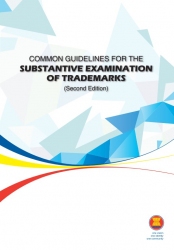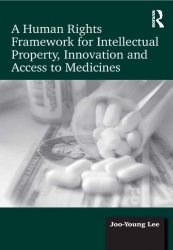
Author : Joo-Young Lee
Publishing Date : Mar 09, 2016
This book examines the relationship between intellectual property in pharmaceuticals and access to medicines from a human rights perspective, with a view to contributing to the development of a human rights framework that can guide States in enacting and implementing intellectual property law and policy. The study primarily explores whether conflicts between patents and human rights in the context of access to medicines are inevitable, or whether patents can be made to serve human rights. What could be a normative framework that human rights might provide for patents and innovation? Joo-Young Lee argues that it is necessary to have a deepened understanding of each of the two sets of norms that govern this issue, that is, patent law and international human rights law. The chapters investigate the relevant dimensions of patent law, and analyse particular human rights bearing upon the issue of intellectual property and access to medicines. This study will be of great interest to academic specialists, practitioners or professionals in the fields of human rights, trade, and intellectual property, as well as policy makers, activists, and health professionals across the world working in intellectual property and human rights.
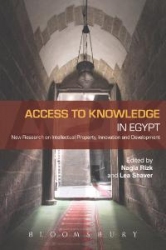
Author : Nagla Rizk
Publishing Date : Apr 29, 2014
This book is an important contribution to recovering a nuanced, contextually aware view of access to knowledge and global knowledge governance Yochaie Benkler, Harvard Law School
This is a 'must read' for scholars and practioners interested in economic devlopment, cultural production and access to knowledge Susan Sell, George Washington University
This volume features five chapters on current issues facing intellectual property, innovation and development policy from the Egyptian perspective. These include: information and communications technology for development, copyright and comparative business models in music, free and open source software, patent reform and access to medicines, and the role of the Egyptian government in promoting access to knowledge internationally and domestically.
Together these chapters offer an overview of the challenges and opportunities facing efforts to promote access to knowledge. Combining both theoretical and pragmatic approaches, the work will be of interest to scholars and practitioners dealing with intellectual property and innovation property the world over.

Author : Ramesh Subramanian, Lea Shaver
Publishing Date : Apr 29, 2014
This is the third volume in our Access to Knowledge series. India is a $1 trillion economy which nevertheless struggles with a very high poverty rate and very low access to knowledge for almost seventy percent of its population which lives in rural areas.
This volume features four parts on current issues facing intellectual property, development policy (especially rural development policy) and associated innovation, from the Indian perspective. Each chapter is authored by scholars taking an interdisciplinary approach and affiliated to Indian or American universities and Indian think-tanks. Each examines a policy area that significantly impacts access to knowledge. These include information and communications technology for development; the Indian digital divide; networking rural areas; copyright and comparative business models in music; free and open source software; patent reform and access to medicines; the role of the Indian government in promoting access to knowledge internationally and domestically.
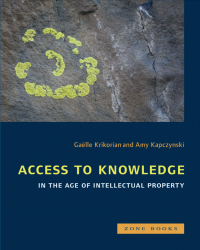
Author : Krikorian, Gaëlle; Kapczynski, Amy
Publishing Date : Mar 20, 2023
A movement emerges to challenge the tightening of intellectual property law around the world.At the end of the twentieth century, intellectual property rights collided with everyday life. Expansive copyright laws and digital rights management technologies sought to shut down new forms of copying and remixing made possible by the Internet. International laws expanding patent rights threatened the lives of millions of people around the world living with HIV/AIDS by limiting their access to cheap generic medicines. For decades, governments have tightened the grip of intellectual property law at the bidding of information industries; but recently, groups have emerged around the world to challenge this wave of enclosure with a new counter-politics of “access to knowledge” or “A2K.” They include software programmers who took to the streets to defeat software patents in Europe, AIDS activists who forced multinational pharmaceutical companies to permit copies of their medicines to be sold in poor countries, subsistence farmers defending their rights to food security or access to agricultural biotechnology, and college students who created a new “free culture” movement to defend the digital commons. Access to Knowledge in the Age of Intellectual Property maps this emerging field of activism as a series of historical moments, strategies, and concepts. It gathers some of the most important thinkers and advocates in the field to make the stakes and strategies at play in this new domain visible and the terms of intellectual property law intelligible in their political implications around the world. A Creative Commons edition of this work will be freely available online.

Author : Correa, Carlos M., Hilty, Reto M.
Publishing Date : Mar 20, 2023
This open access book is the outcome of a Global Forum on Innovation, Intellectual Property and Access to Medicines held in December 2019 at the Max Plank Instititute in Munich, organised by the South Centre and the Max Plank Institute. The academics and experts from international organisations participating have contributed chapters to this book. The book is for policy makers (in Ministries of Health, Ministries of Trade, Ministries of Foreign Affairs, patent offices), but also relevant for academics (law, trade, public health), on the flexibilities available in the Agreement on Trade Related Aspects of Intellectual Property Rights (TRIPS) of the World Trade Organization to promote access to medicines.
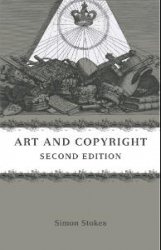
Author : Simon Stokes
Publishing Date : Sep 25, 2014
The intellectual property protection afforded to works of art is receiving increased attention by artists, museums, galleries, auction houses, publishers and their professional staff and legal advisors, as well as by those teaching or studying copyright and/or the law of cultural property.
Contemporary artists are pushing copyright law to extremes. The European Union is likely to soon formally adopt an artists’ resale right (droit de suite) directive. The recent adoption of the digital copyright directive will also further strengthen the rights of artists as regards the exploitation of their works via the Internet.
This is the first text to specifically examine in detail the intellectual property rights protecting artistic works and artists’ rights generally in the United Kingdom. The focus is on the UK but where appropriate other relevant jurisdictions are discussed. Recent European developments and the evolving UK case law in this area including the recent House of Lords’ decision in Designers Guild v Russell Williams are also addressed. The Internet and related intellectual property rights to copyright and moral rights are considered as well, including the law of passing off, breach of confidence, trade marks and domain name protection.
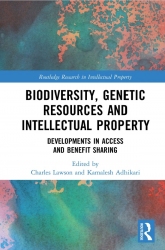
- Biodiversity, Genetic Resources and Intellectual Property Developments in Access and Benefit Sharing
Author : Kamalesh Adhikari, Charles Lawson
Publishing Date : May 04, 2020
Debates about Access and Benefit Sharing (ABS) have moved on in recent years. An initial focus on the legal obligations established by international agreements like the United Nations Convention on Biological Diversity and the form of obligations for collecting physical biological materials have now moved to a far more complex series of disputes and challenges about the ways ABS should be implemented and enforced: repatriation of resources, technology transfer, traditional knowledge and cultural expressions; open access to information and knowledge, naming conventions, farmers’ rights, new schemes for accessing pandemic viruses and sharing DNA sequences, and so on. Unfortunately, most of this debate is now crystallised into apparently intractable discussions such as implementing the certificates of origin, recognising traditional knowledge and traditional cultural expression as a form of intellectual property, and sovereignty for Indigenous peoples. Not everything in this new marketplace of ABS has been created de novo. Like most new entrants, ABS has disrupted existing legal and governance arrangements. This collection of chapters examines what is new, what has been changed, and what might be changed in response to the growing acceptance and prevalence of ABS of genetic resources.
Biodiversity, Genetic Resources and Intellectual Property: Developments in Access and Benefit Sharing of Genetic Resources addresses current issues arising from recent developments in the enduring and topical debates about managing genetic resources through the ABS regime. The book explores key historical, doctrinal, and theoretical issues in the field, at the same time developing new ideas and perspectives around ABS. It shows the latest state of knowledge and will be of interest to researchers, academics, policymakers, and students in the fields of intellectual property, governance, biodiversity and conservation, sustainable development, and agriculture.

Author : Maureen O'Sullivan
Publishing Date : Jun 19, 2019
This book critiques the decision-making process in Article 53(a) of the European Patent Convention. To date, such decisions have been taken at high levels of expertise without much public involvement. The book eschews traditional solutions, such as those found within legislative, judicial and patent office realms and instead develops a radical blueprint for how these decisions can be put to the public. By examining wide-scale models of participatory democracy and deliberation, this book fills a significant gap in the literature. It will be invaluable for patent lawyers, academics, practitioners and intellectual property and patent officials.
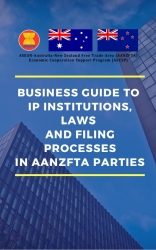
Author : ASEAN Secretariat
Publishing Date : Mar 12, 2020
This Guide is designed for business people of ASEAN Member States, Australia and New Zealand. In aid
of understanding, some examples have been provided, but these are mere illustrations and do not
provide judgment and do not constitute commercial or legal advice. Views or conclusions may have also
been expressed but these should NOT be taken as legal or commercial advice. Any part of the content of
this publication (including images, graphics, trademarks or logos) is only intended for informational and
educational purpose only.
The author and the ASEAN Secretariat have taken due diligence in the preparation of this publication.
However, they shall not be held liable for any omissions or inaccuracies in the content of this
publication. Neither the authors, the ASEAN Secretariat, Australian and New Zealand Governments
accept any liability for any claims, loss or expenses that may arise or arising from use of information in
this publication. Reliance on the information is at the user’s sole risk/responsibility.
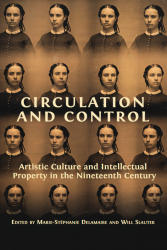
Author : Delamaire, Marie-Stéphanie
Publishing Date : May 15, 2023
The nineteenth century witnessed a series of revolutions in the production and circulation of images. From lithographs and engraved reproductions of paintings to daguerreotypes, stereoscopic views, and mass-produced sculptures, works of visual art became available in a wider range of media than ever before. But the circulation and reproduction of artworks also raised new questions about the legal rights of painters, sculptors, engravers, photographers, architects, collectors, publishers, and subjects of representation (such as sitters in paintings or photographs). Copyright and patent laws tussled with informal cultural norms and business strategies as individuals and groups attempted to exert some degree of control over these visual creations. With contributions by art historians, legal scholars, historians of publishing, and specialists of painting, photography, sculpture, and graphic arts, this rich collection of essays explores the relationship between intellectual property laws and the cultural, economic, and technological factors that transformed the pictorial landscape during the nineteenth century. This book will be valuable reading for historians of art and visual culture; legal scholars who work on the history of copyright and patent law; and literary scholars and historians who work in the field of book history. It will also resonate with anyone interested in current debates about the circulation and control of images in our digital age.
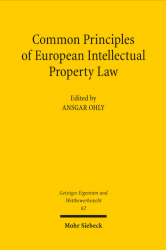
Author : Ohly, Ansgar
Publishing Date : May 15, 2023
Intellectual property law has been harmonized by EU law to a considerable extent. At the same time intellectual property rights have converged. The academic discussion has not kept pace with this development. European intellectual property law is often seen through the spectacles of national law; pan-European discussions about issues of Community law seem to be the exception rather than the rule. The contributors to this volume investigate if and to what extent European rules and principles applicable to all intellectual property rights already exist or whether they can be found on the basis of the acquis communautaire and comparative law. In particular, they discuss the merits and the methodology of common principles before turning to several areas of substantive intellectual property law such as grounds of protection, secondary liability and exceptions, to enforcement and finally to the relationship between intellectual property and neighbouring areas of EU law.
123NextLast

